- Search Please fill out this field.
- Manage Your Subscription
- Give a Gift Subscription
- Newsletters
- Sweepstakes
- Space Travel + Astronomy

Here's What Actually Happens When You Travel at the Speed of Light, According to NASA
NASA created a fun video to answer all of our burning questions about near-light-speed travel.
:max_bytes(150000):strip_icc():format(webp)/Stacey-Leasca-2000-631fabdcfe624115bea0ce8e25fdec96.jpg)
Ever wish you could travel at the speed of light to your favorite destinations ? Once you see the reality of that speed, you may rethink everything.
"There are some important things you should probably know about approaching the speed of light," NASA's video, Guide to Near-light-speed Travel , explains. "First, a lot of weird things can happen, like time and space getting all bent out of shape."
According to the video, if you're traveling at nearly the speed of light, the clock inside your rocket would show it takes less time to travel to your destination than it would on Earth. But, since the clocks at home would be moving at a standard rate you'd return home to everyone else being quite a bit older.
"Also, because you're going so fast, what would otherwise be just a few hydrogen atoms that you'd run into quickly becomes a lot of dangerous particles. So you should probably have shields that keep them from frying your ship and also you."
Finally, the video tackles the fact that even if you were moving at the speed of light, the "universe is also a very big place, so you might be in for some surprises." For example, your rocket's clock will say it takes about nine months to get from Earth to the edge of the solar system. An Earth clock would say it took about a year and a half. Fortunately, NASA astronauts have a slew of tips for avoiding jet lag along the way.
"If you want to get to farther out vacation spots," the video explains, "you'll probably need more than a few extra snacks. A trip to the Andromeda Galaxy, our nearest large neighbor galaxy, can take over one million years. And a trip to the farthest known galaxy where it currently sits might take over 15 billion years, which is more vacation time than I think I'll ever have."
The video doesn't explain how your rocket will travel at the speed of light. Our technology just isn't there yet, but maybe the aliens will share that tech with us soon. Until then, you can track the first crew launch of Artemis II , a rocket that will fly around the moon in 2024 before making its first lunar landing in 2025.
Related Articles

Suggested Searches
- Climate Change
- Expedition 64
- Mars perseverance
- SpaceX Crew-2
- International Space Station
- View All Topics A-Z
Humans in Space
Earth & climate, the solar system, the universe, aeronautics, learning resources, news & events.

Hubble Examines a Busy Galactic Center
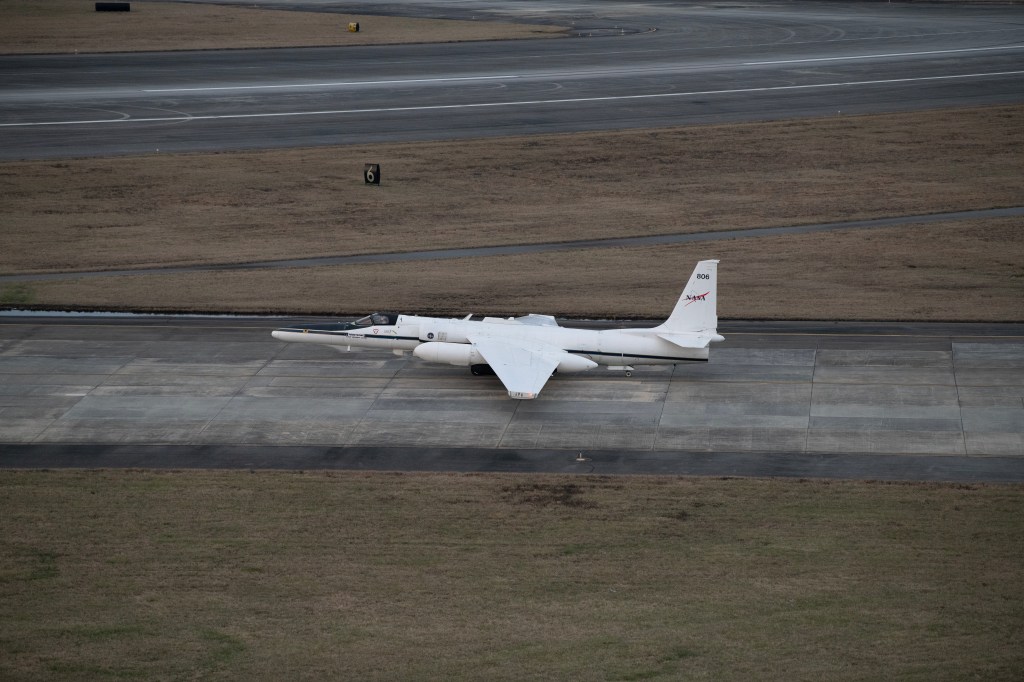
NASA Earth Scientists Take Flight, Set Sail to Verify PACE Satellite Data

What’s Up: September 2024 Skywatching Tips from NASA
- Search All NASA Missions
- A to Z List of Missions
- Upcoming Launches and Landings
- Spaceships and Rockets
- Communicating with Missions
- James Webb Space Telescope
- Hubble Space Telescope
- Why Go to Space
- Commercial Space
- Destinations
- Living in Space
- Explore Earth Science
- Earth, Our Planet
- Earth Science in Action
- Earth Multimedia
- Earth Science Researchers
- Pluto & Dwarf Planets
- Asteroids, Comets & Meteors
- The Kuiper Belt
- The Oort Cloud
- Skywatching
- The Search for Life in the Universe
- Black Holes
- The Big Bang
- Dark Energy & Dark Matter
- Earth Science
- Planetary Science
- Astrophysics & Space Science
- The Sun & Heliophysics
- Biological & Physical Sciences
- Lunar Science
- Citizen Science
- Astromaterials
- Aeronautics Research
- Human Space Travel Research
- Science in the Air
- NASA Aircraft
- Flight Innovation
- Supersonic Flight
- Air Traffic Solutions
- Green Aviation Tech
- Drones & You
- Technology Transfer & Spinoffs
- Space Travel Technology
- Technology Living in Space
- Manufacturing and Materials
- Science Instruments
- For Kids and Students
- For Educators
- For Colleges and Universities
- For Professionals
- Science for Everyone
- Requests for Exhibits, Artifacts, or Speakers
- STEM Engagement at NASA
- NASA's Impacts
- Centers and Facilities
- Directorates
- Organizations
- People of NASA
- Internships
- Our History
- Doing Business with NASA
- Get Involved
NASA en Español
- Aeronáutica
- Ciencias Terrestres
- Sistema Solar
- All NASA News
- Video Series on NASA+
- Newsletters
- Social Media
- Media Resources
- Upcoming Launches & Landings
- Virtual Guest Program
- Image of the Day
- Sounds and Ringtones
- Interactives
- STEM Multimedia

NASA Invites Social Creators to Experience Launch of Europa Clipper Mission

Persevering Through the Storm
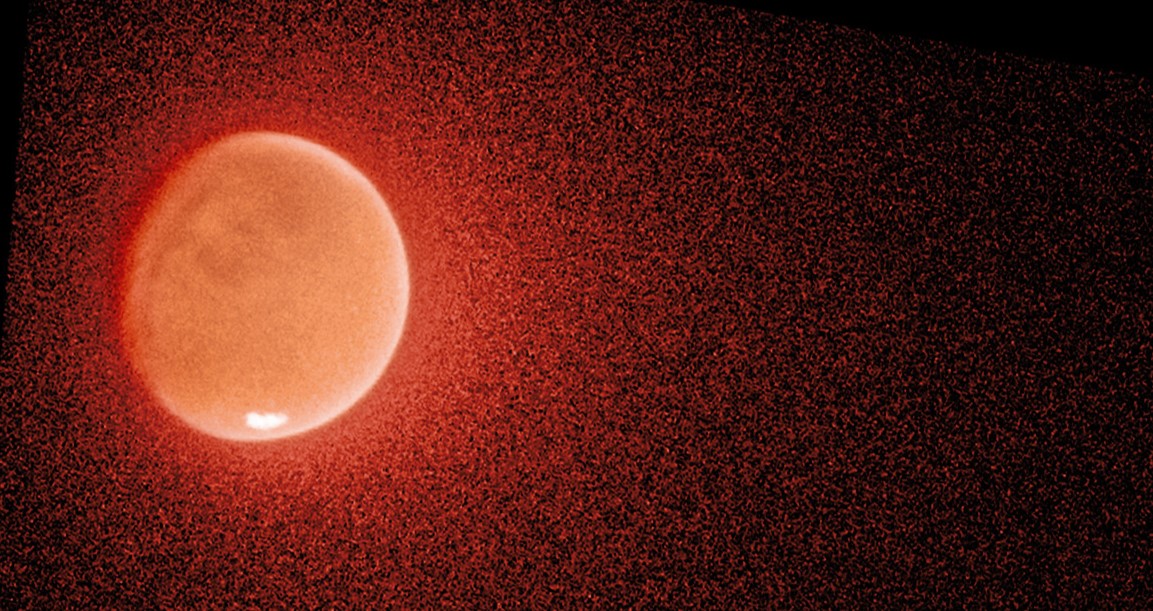
NASA’s Hubble, MAVEN Help Solve the Mystery of Mars’ Escaping Water

NASA Astronaut Don Pettit’s Science of Opportunity on Space Station

NASA, Boeing Optimizing Vehicle Assembly Building High Bay for Future SLS Stage Production

NASA Seeks Input for Astrobee Free-flying Space Robots

NASA Summer Camp Inspires Future Climate Leaders

NASA Mission Gets Its First Snapshot of Polar Heat Emissions
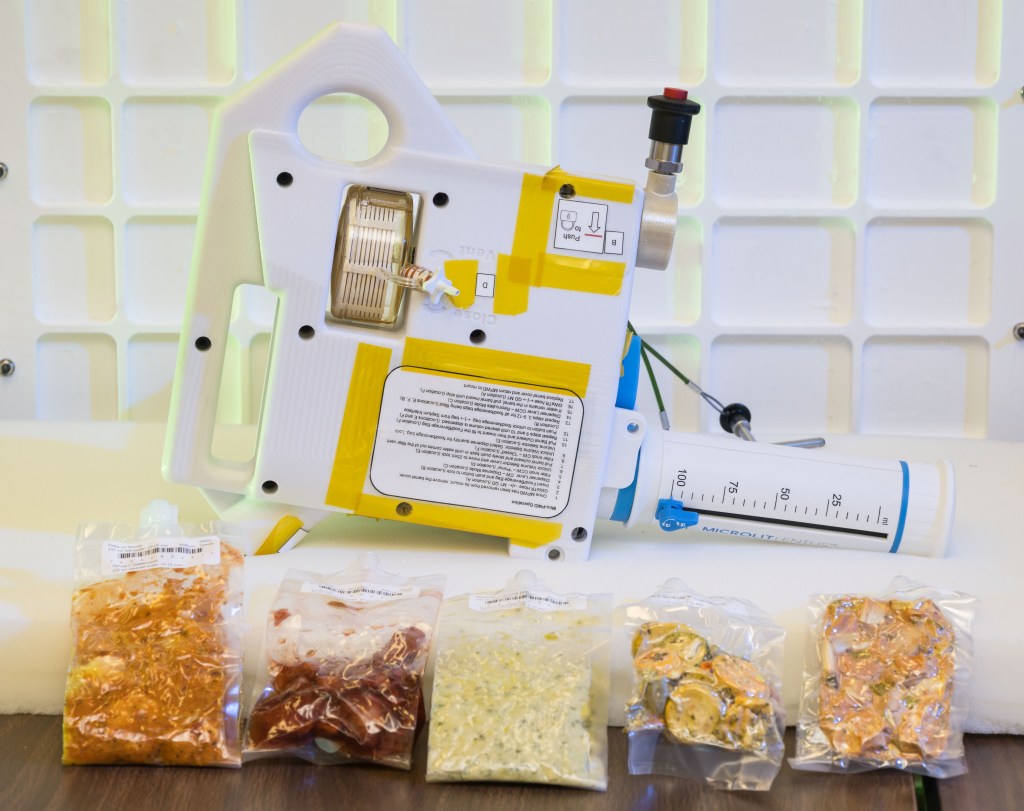
Artemis IV: Gateway Gadget Fuels Deep Space Dining
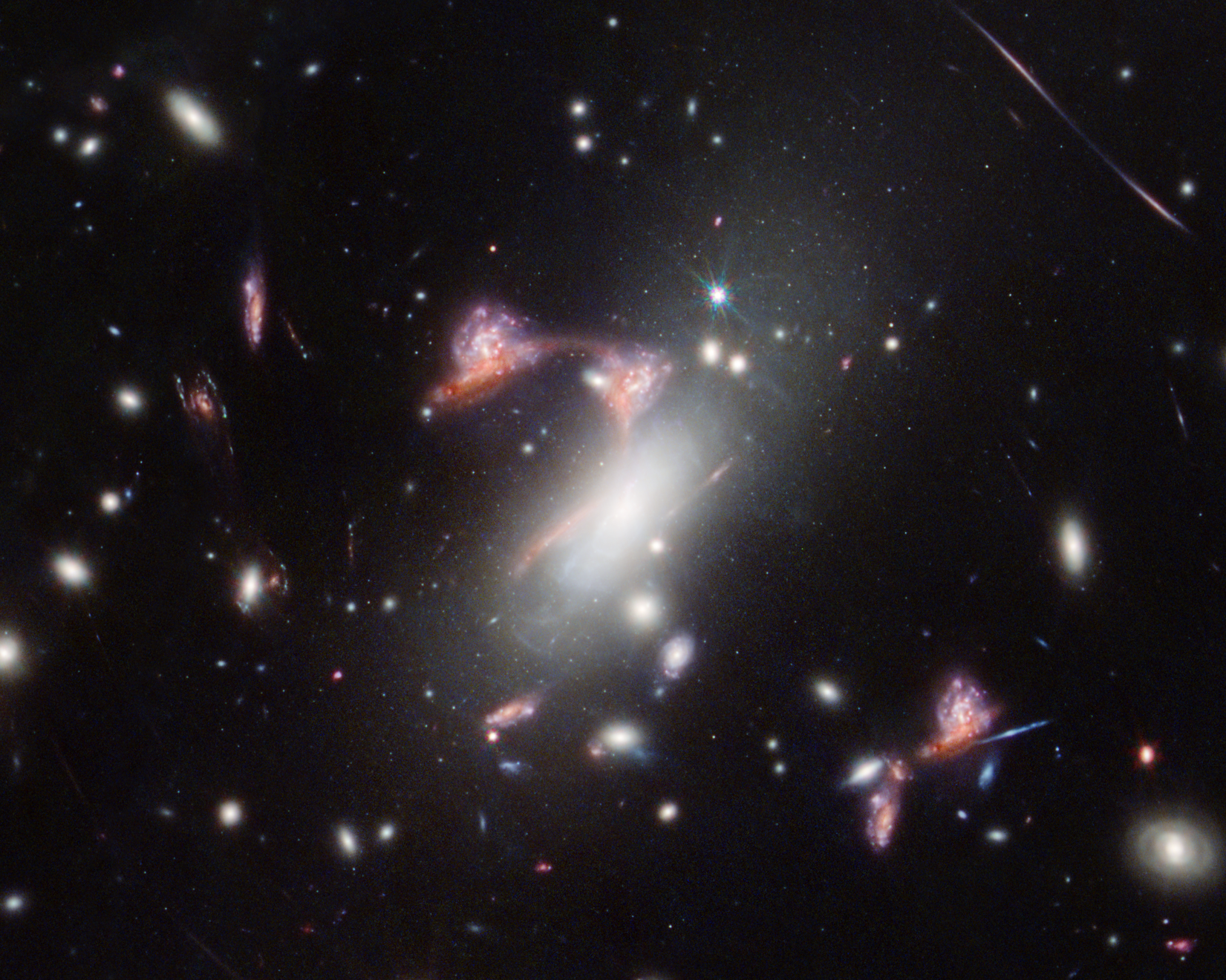
NASA’s Webb Reveals Distorted Galaxy Forming Cosmic Question Mark

NASA’s Mini BurstCube Mission Detects Mega Blast
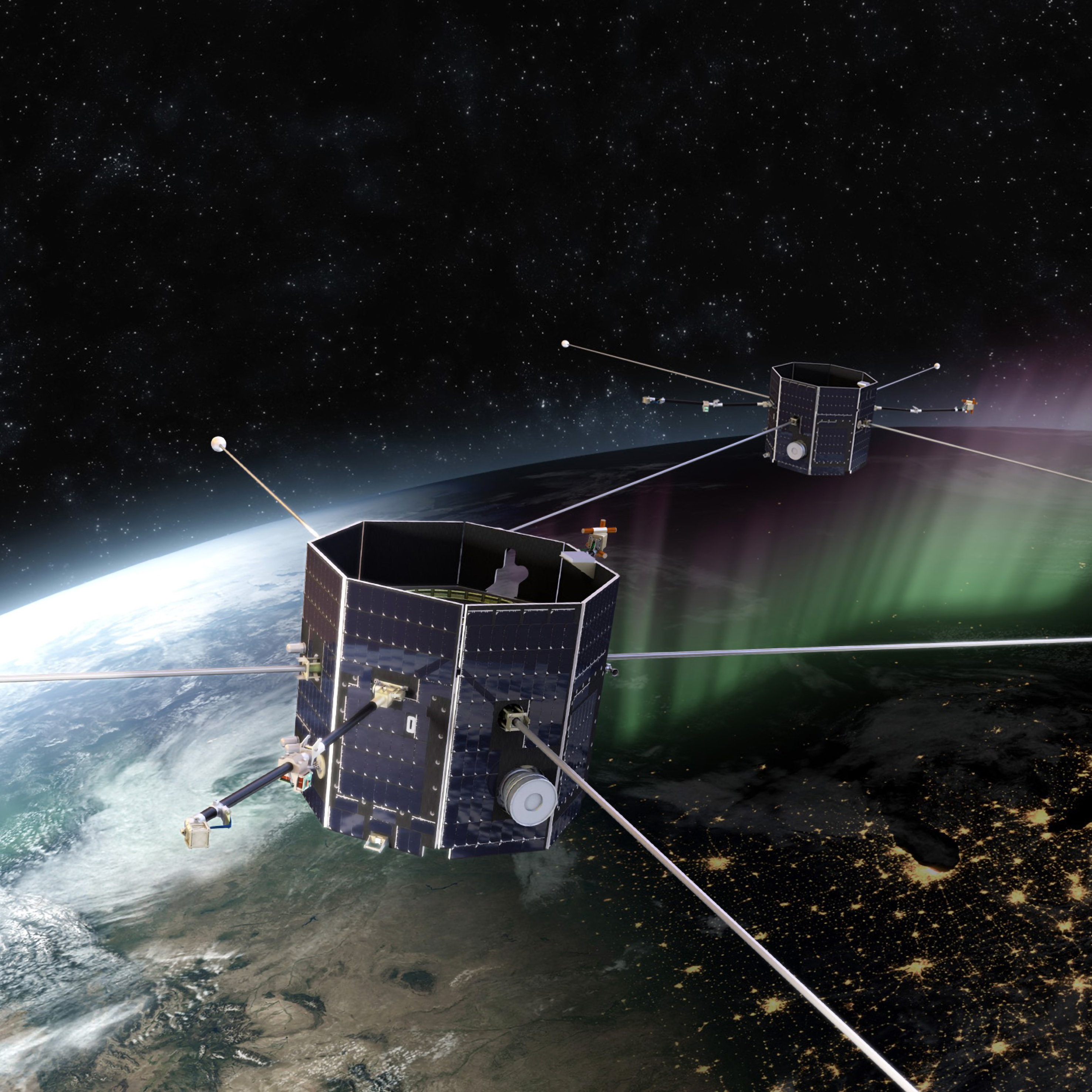
NASA Tunnel Generates Decades of Icy Aircraft Safety Data

Research Plane Dons New Colors for NASA Hybrid Electric Flight Tests

NASA G-IV Plane Will Carry Next-Generation Science Instrument

OSAM-1 Partnership Opportunity: Request for Information
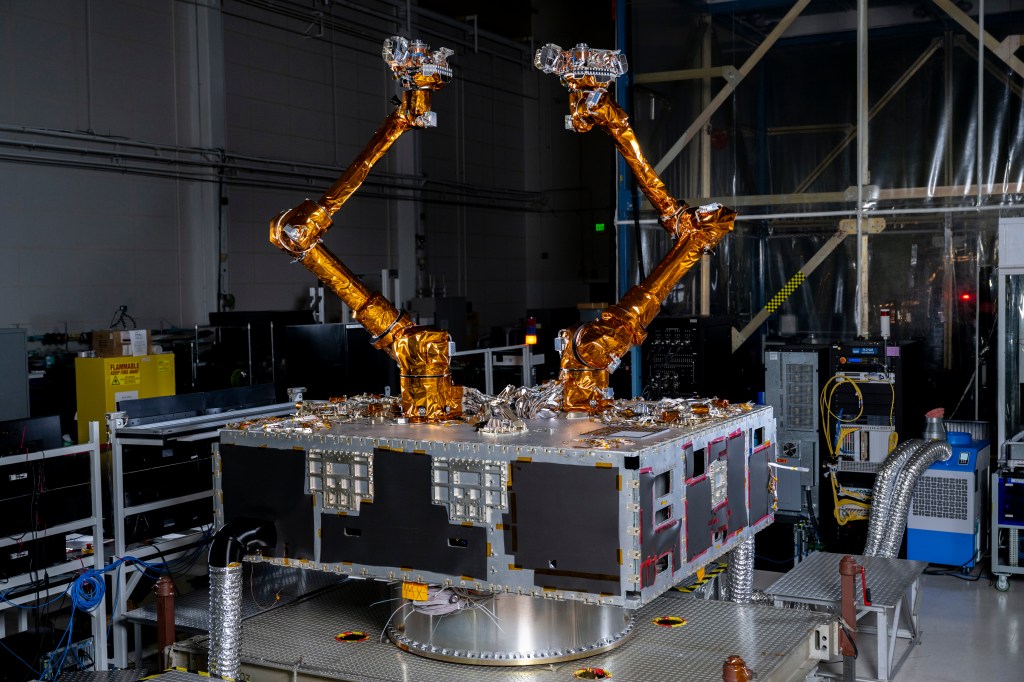
NASA to Support DARPA Robotic Satellite Servicing Program

NASA JPL Developing Underwater Robots to Venture Deep Below Polar Ice
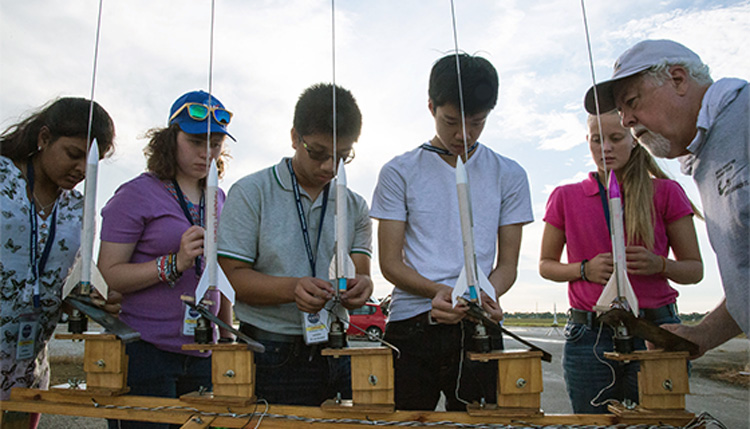
Learn Math with NASA Science

Eclipses Create Atmospheric Gravity Waves, NASA Student Teams Confirm

La NASA invita a los medios al lanzamiento de Europa Clipper

El X-59 de la NASA avanza en las pruebas de preparación para volar

La NASA invita a creadores de las redes sociales al lanzamiento de la misión Europa Clipper
How to travel at (nearly) the speed of light.

One hundred years ago, on May 29, 1919, measurements of a solar eclipse offered proof for Einstein’s theory of general relativity. Even before that, Einstein had developed the theory of special relativity, which revolutionized the way we understand light. To this day, it provides guidance on understanding how particles move through space — a key area of research to keep spacecraft and astronauts safe from radiation.
The theory of special relativity showed that particles of light, photons, travel through a vacuum at a constant pace of 670,616,629 miles per hour — a speed that’s immensely difficult to achieve and impossible to surpass in that environment. Yet all across space, from black holes to our near-Earth environment, particles are, in fact, being accelerated to incredible speeds, some even reaching 99.9% the speed of light.
Scientists suspect magnetic reconnection is one way that particles are accelerated to nearly light speed. This illustration depicts the magnetic fields around Earth, which snap and realign, causing charged particles to be flung away at high speeds. Find out all three ways that this acceleration happens .
Image Credit: NASA

- Login/Register
- Solar System
- Exotic Objects
- Upcoming Events
- Deep-Sky Objects
- Observing Basics
- Telescopes and Equipment
- Astrophotography
- Space Exploration
- Human Spaceflight
- Robotic Spaceflight
- The Magazine
What is the speed of light? Here’s the history, discovery of the cosmic speed limit
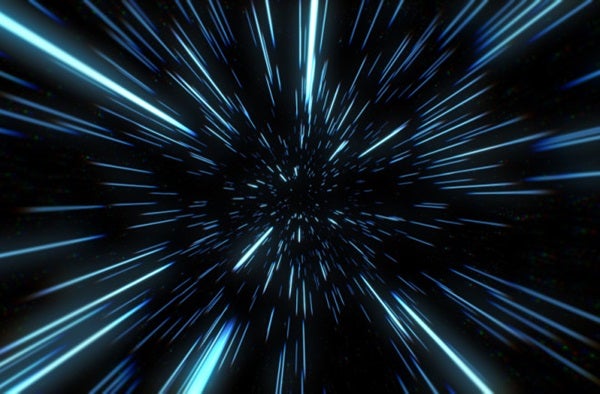
On one hand, the speed of light is just a number: 299,792,458 meters per second. And on the other, it’s one of the most important constants that appears in nature and defines the relationship of causality itself.
As far as we can measure, it is a constant. It is the same speed for every observer in the entire universe. This constancy was first established in the late 1800’s with the experiments of Albert Michelson and Edward Morley at Case Western Reserve University . They attempted to measure changes in the speed of light as the Earth orbited around the Sun. They found no such variation, and no experiment ever since then has either.
Observations of the cosmic microwave background, the light released when the universe was 380,000 years old, show that the speed of light hasn’t measurably changed in over 13.8 billion years.
In fact, we now define the speed of light to be a constant, with a precise speed of 299,792,458 meters per second. While it remains a remote possibility in deeply theoretical physics that light may not be a constant, for all known purposes it is a constant, so it’s better to just define it and move on with life.
How was the speed of light first measured?
In 1676 the Danish astronomer Ole Christensen Romer made the first quantitative measurement of how fast light travels. He carefully observed the orbit of Io, the innermost moon of Jupiter. As the Earth circles the Sun in its own orbit, sometimes it approaches Jupiter and sometimes it recedes away from it. When the Earth is approaching Jupiter, the path that light has to travel from Io is shorter than when the Earth is receding away from Jupiter. By carefully measuring the changes to Io’s orbital period, Romer calculated a speed of light of around 220,000 kilometers per second.
Observations continued to improve until by the 19 th century astronomers and physicists had developed the sophistication to get very close to the modern value. In 1865, James Clerk Maxwell made a remarkable discovery. He was investigating the properties of electricity and magnetism, which for decades had remained mysterious in unconnected laboratory experiments around the world. Maxwell found that electricity and magnetism were really two sides of the same coin, both manifestations of a single electromagnetic force.
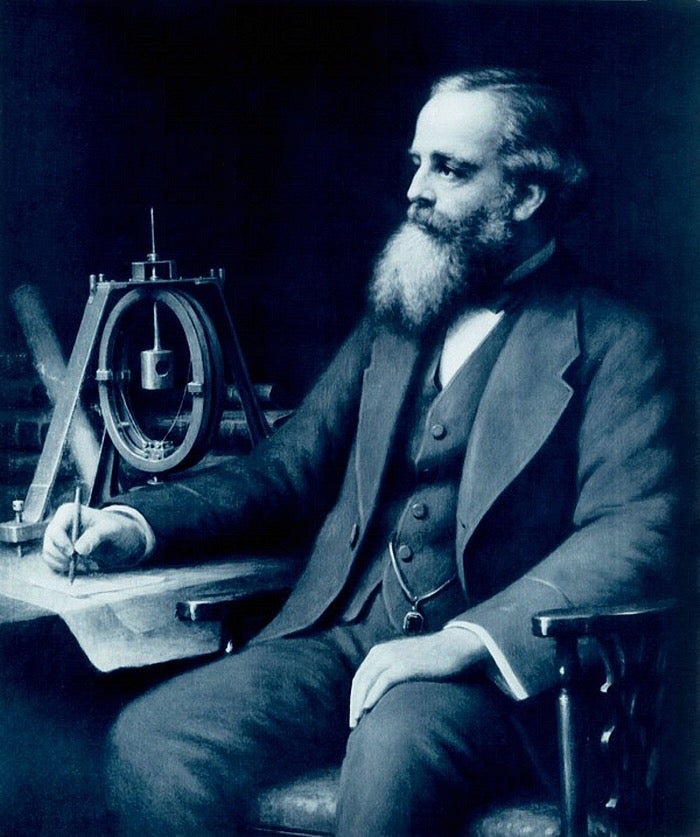
As Maxwell explored the consequences of his new theory, he found that changing magnetic fields can lead to changing electric fields, which then lead to a new round of changing magnetic fields. The fields leapfrog over each other and can even travel through empty space. When Maxwell went to calculate the speed of these electromagnetic waves, he was surprised to see the speed of light pop out – the first theoretical calculation of this important number.
What is the most precise measurement of the speed of light?
Because it is defined to be a constant, there’s no need to measure it further. The number we’ve defined is it, with no uncertainty, no error bars. It’s done. But the speed of light is just that – a speed. The number we choose to represent it depends on the units we use: kilometers versus miles, seconds versus hours, and so on. In fact, physicists commonly just set the speed of light to be 1 to make their calculations easier. So instead of trying to measure the speed light travels, physicists turn to more precisely measuring other units, like the length of the meter or the duration of the second. In other words, the defined value of the speed of light is used to establish the length of other units like the meter.
How does light slow down?
Yes, the speed of light is always a constant. But it slows down whenever it travels through a medium like air or water. How does this work? There are a few different ways to present an answer to this question, depending on whether you prefer a particle-like picture or a wave-like picture.
In a particle-like picture, light is made of tiny little bullets called photons. All those photons always travel at the speed of light, but as light passes through a medium those photons get all tangled up, bouncing around among all the molecules of the medium. This slows down the overall propagation of light, because it takes more time for the group of photons to make it through.
In a wave-like picture, light is made of electromagnetic waves. When these waves pass through a medium, they get all the charged particles in motion, which in turn generate new electromagnetic waves of their own. These interfere with the original light, forcing it to slow down as it passes through.
Either way, light always travels at the same speed, but matter can interfere with its travel, making it slow down.
Why is the speed of light important?
The speed of light is important because it’s about way more than, well, the speed of light. In the early 1900’s Einstein realized just how special this speed is. The old physics, dominated by the work of Isaac Newton, said that the universe had a fixed reference frame from which we could measure all motion. This is why Michelson and Morley went looking for changes in the speed, because it should change depending on our point of view. But their experiments showed that the speed was always constant, so what gives?
Einstein decided to take this experiment at face value. He assumed that the speed of light is a true, fundamental constant. No matter where you are, no matter how fast you’re moving, you’ll always see the same speed.
This is wild to think about. If you’re traveling at 99% the speed of light and turn on a flashlight, the beam will race ahead of you at…exactly the speed of light, no more, no less. If you’re coming from the opposite direction, you’ll still also measure the exact same speed.
This constancy forms the basis of Einstein’s special theory of relativity, which tells us that while all motion is relative – different observers won’t always agree on the length of measurements or the duration of events – some things are truly universal, like the speed of light.
Can you go faster than light speed?
Nope. Nothing can. Any particle with zero mass must travel at light speed. But anything with mass (which is most of the universe) cannot. The problem is relativity. The faster you go, the more energy you have. But we know from Einstein’s relativity that energy and mass are the same thing. So the more energy you have, the more mass you have, which makes it harder for you to go even faster. You can get as close as you want to the speed of light, but to actually crack that barrier takes an infinite amount of energy. So don’t even try.
How is the speed at which light travels related to causality?
If you think you can find a cheat to get around the limitations of light speed, then I need to tell you about its role in special relativity. You see, it’s not just about light. It just so happens that light travels at this special speed, and it was the first thing we discovered to travel at this speed. So it could have had another name. Indeed, a better name for this speed might be “the speed of time.”
Related: Is time travel possible? An astrophysicist explains
We live in a universe of causes and effects. All effects are preceded by a cause, and all causes lead to effects. The speed of light limits how quickly causes can lead to effects. Because it’s a maximum speed limit for any motion or interaction, in a given amount of time there’s a limit to what I can influence. If I want to tap you on the shoulder and you’re right next to me, I can do it right away. But if you’re on the other side of the planet, I have to travel there first. The motion of me traveling to you is limited by the speed of light, so that sets how quickly I can tap you on the shoulder – the speed light travels dictates how quickly a single cause can create an effect.
The ability to go faster than light would allow effects to happen before their causes. In essence, time travel into the past would be possible with faster-than-light travel. Since we view time as the unbroken chain of causes and effects going from the past to the future, breaking the speed of light would break causality, which would seriously undermine our sense of the forward motion of time.
Why does light travel at this speed?
No clue. It appears to us as a fundamental constant of nature. We have no theory of physics that explains its existence or why it has the value that it does. We hope that a future understanding of nature will provide this explanation, but right now all investigations are purely theoretical. For now, we just have to take it as a given.
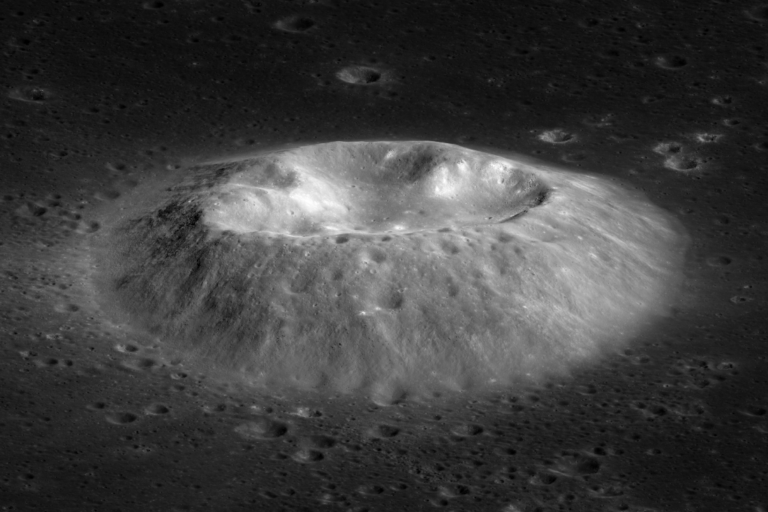
Volcanoes were erupting on the Moon while dinosaurs roamed Earth, Chang’e 5 samples suggest

New Horizons measures how dark the universe can get

What we do — and don’t — know about dark energy

Get to know the Andromeda Galaxy
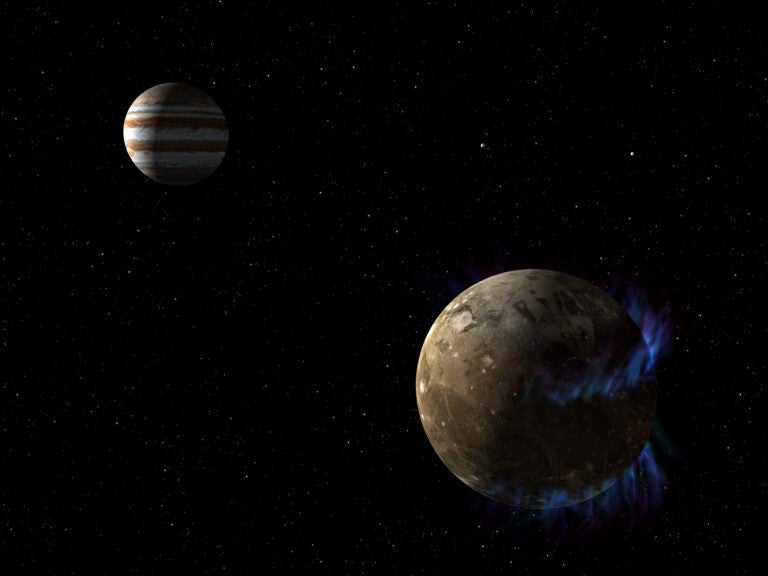

Scientists view Ganymede’s aurorae dancing during eclipse
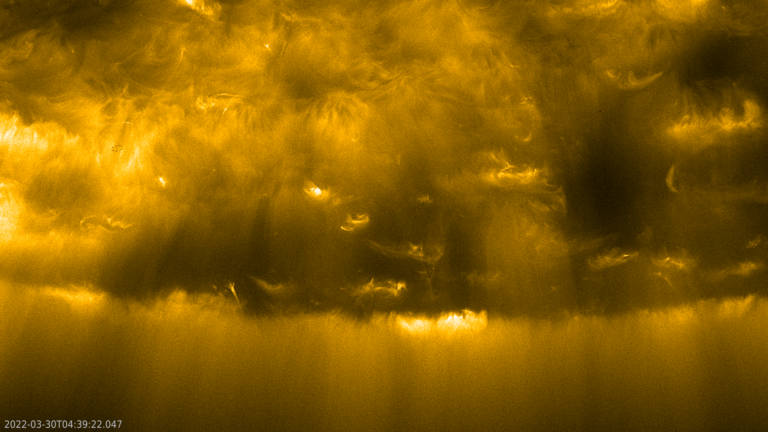
Waves may be heating the solar wind — and two spacecraft caught them in action
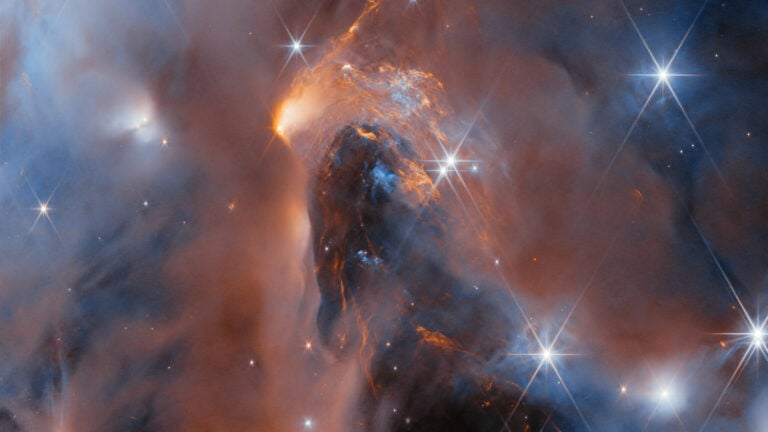
Rogue worlds may give clues as to how stars form
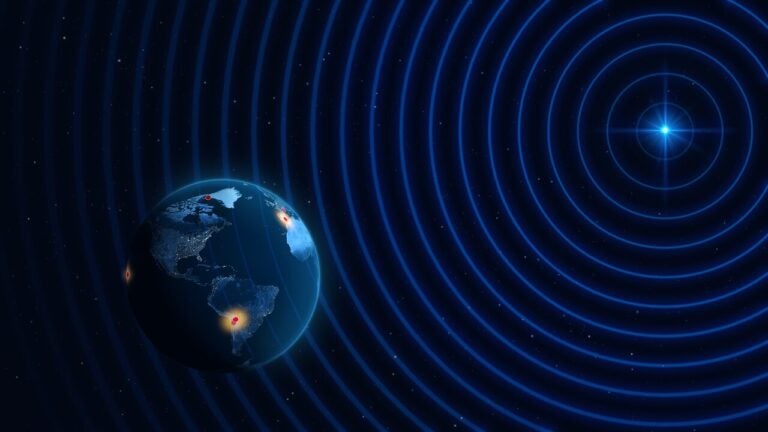
Event Horizon Telescope captures highest-resolution images ever taken from the ground
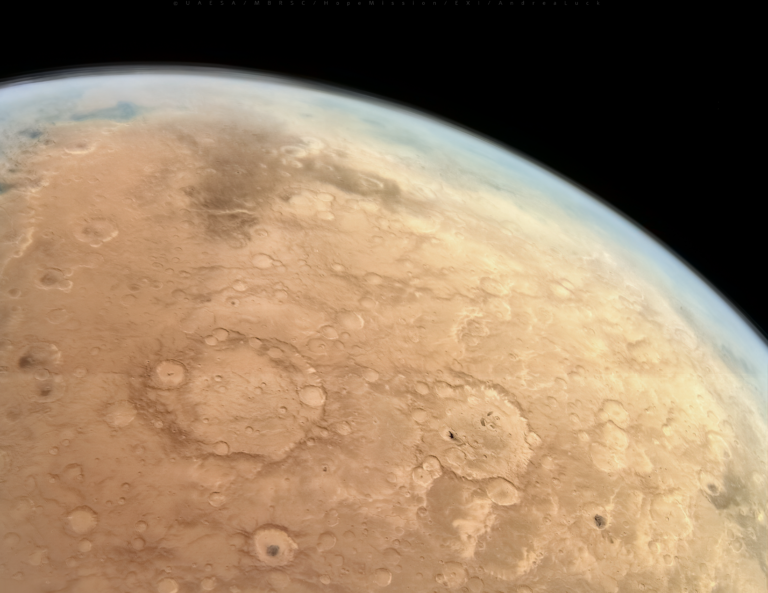
New study suggests we could give Mars a thicker atmosphere — using dust

Can anything travel faster than the speed of light?
Does it matter if it's in a vacuum?

In 1676, by studying the motion of Jupiter's moon Io, Danish astronomer Ole Rømer calculated that light travels at a finite speed. Two years later, building on data gathered by Rømer, Dutch mathematician and scientist Christiaan Huygens became the first person to attempt to determine the actual speed of light, according to the American Museum of Natural History in New York City. Huygens came up with a figure of 131,000 miles per second (211,000 kilometers per second), a number that isn't accurate by today's standards — we now know that the speed of light in the "vacuum" of empty space is about 186,282 miles per second (299,792 km per second) — but his assessment showcased that light travels at an incredible speed.
According to Albert Einstein 's theory of special relativity , light travels so fast that, in a vacuum, nothing in the universe is capable of moving faster.
"We cannot move through the vacuum of space faster than the speed of light," confirmed Jason Cassibry, an associate professor of aerospace engineering at the Propulsion Research Center, University of Alabama in Huntsville.
Question answered, right? Maybe not. When light is not in a vacuum, does the rule still apply?
Related: How many atoms are in the observable universe?
"Technically, the statement 'nothing can travel faster than the speed of light' isn't quite correct by itself," at least in a non-vacuum setting, Claudia de Rham, a theoretical physicist at Imperial College London, told Live Science in an email. But there are certain caveats to consider, she said. Light exhibits both particle-like and wave-like characteristics, and can therefore be regarded as both a particle (a photon ) and a wave. This is known as wave-particle duality.
If we look at light as a wave, then there are "multiple reasons" why certain waves can travel faster than white (or colorless) light in a medium, de Rham said. One such reason, she said, is that "as light travels through a medium — for instance, glass or water droplets — the different frequencies or colors of light travel at different speeds." The most obvious visual example of this occurs in rainbows, which typically have the long, faster red wavelengths at the top and the short, slower violet wavelengths at the bottom, according to a post by the University of Wisconsin-Madison .
Sign up for the Live Science daily newsletter now
Get the world’s most fascinating discoveries delivered straight to your inbox.
When light travels through a vacuum, however, the same is not true. "All light is a type of electromagnetic wave, and they all have the same speed in a vacuum (3 x 10^8 meters per second). This means both radio waves and gamma rays have the same speed," Rhett Allain, a physics professor at Southeastern Louisiana University, told Live Science in an email.
So, according to de Rham, the only thing capable of traveling faster than the speed of light is, somewhat paradoxically, light itself, though only when not in the vacuum of space. Of note, regardless of the medium, light will never exceed its maximum speed of 186,282 miles per second.
Universal look
According to Cassibry, however, there is something else to consider when discussing things moving faster than the speed of light.
"There are parts of the universe that are expanding away from us faster than the speed of light, because space-time is expanding," he said. For example, the Hubble Space Telescope recently spotted 12.9 billion year-old light from a distant star known as Earendel. But, because the universe is expanding at every point, Earendel is moving away from Earth and has been since its formation, so the galaxy is now 28 billion light years away from Earth.
In this case, space-time is expanding, but the material in space-time is still traveling within the bounds of light speed.
Related: Why is space a vacuum?
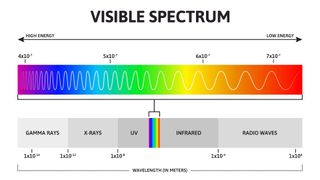
So, it's clear that nothing travels faster than light that we know of, but is there any situation where it might be possible? Einstein's theory of special relativity, and his subsequent theory of general relativity, is "built under the principle that the notions of space and time are relative," de Rham said. But what does this mean? "If someone [were] able to travel faster than light and carry information with them, their notion of time would be twisted as compared to ours," de Rham said. "There could be situations where the future could affect our past, and then the whole structure of reality would stop making sense."
This would indicate that it would probably not be desirable to make a human travel faster than the speed of light. But could it ever be possible? Will there ever be a time when we are capable of creating craft that could propel materials — and ultimately humans — through space at a pace that outstrips light speed? "Theorists have proposed various types of warp bubbles that could enable faster-than-light travel," Cassibry said.
But is de Rham convinced?
"We can imagine being able to communicate at the speed of light with systems outside our solar system ," de Rham said. "But sending actual physical humans at the speed of light is simply impossible, because we cannot accelerate ourselves to such speed.
"Even in a very idealistic situation where we imagine we could keep accelerating ourselves at a constant rate — ignoring how we could even reach a technology that could keep accelerating us continuously — we would never actually reach the speed of light," she added. "We could get close, but never quite reach it."
Related: How long is a galactic year?
This is a point confirmed by Cassibry. "Neglecting relativity, if you were to accelerate with a rate of 1G [Earth gravity], it would take you a year to reach the speed of light. However, you would never really reach that velocity because as you start to approach lightspeed, your mass energy increases, approaching infinite. "One of the few known possible 'cheat codes' for this limitation is to expand and contract spacetime, thereby pulling your destination closer to you. There seems to be no fundamental limit on the rate at which spacetime can expand or contract, meaning we might be able to get around this velocity limit someday."
— What would happen if the speed of light were much lower?
— What if the speed of sound were as fast as the speed of light?
— How does the rubber pencil illusion work?
Allain is similarly confident that going faster than light is far from likely, but, like Cassibry, noted that if humans want to explore distant planets, it may not actually be necessary to reach such speeds. "The only way we could understand going faster than light would be to use some type of wormhole in space," Allain said. "This wouldn't actually make us go faster than light, but instead give us a shortcut to some other location in space."
Cassibry, however, is unsure if wormholes will ever be a realistic option.
"Wormholes are theorized to be possible based on a special solution to Einstein's field equations," he said. "Basically, wormholes, if possible, would give you a shortcut from one destination to another. I have no idea if it's possible to construct one, or how we would even go about doing it." Originally published on Live Science.
Joe Phelan is a journalist based in London. His work has appeared in VICE, National Geographic, World Soccer and The Blizzard, and has been a guest on Times Radio. He is drawn to the weird, wonderful and under examined, as well as anything related to life in the Arctic Circle. He holds a bachelor's degree in journalism from the University of Chester.
Asteroid 10 times bigger than the dinosaur-killing space rock smashed Jupiter's largest moon off its axis
The oldest evidence of Earth's atmosphere may be hiding in rocks on the moon
Pollution harms men's fertility, but traffic noise affects women's
Most Popular
- 2 Asteroid 10 times bigger than the dinosaur-killing space rock smashed Jupiter's largest moon off its axis
- 3 Stone Age burial ground in France used for 800 years is nearly all male — and ancient DNA reveals they're largely related
- 4 The oldest evidence of Earth's atmosphere may be hiding in rocks on the moon
- 5 Sexually frustrated dolphin behind spate of attacks on humans off Japan
Have we made an object that could travel 1% the speed of light?
University Distinguished Professor of Astronomy, University of Arizona
Disclosure statement
Chris Impey receives funding from the National Science Foundation and the Hearst Foundation.
University of Arizona provides funding as a member of The Conversation US.
View all partners
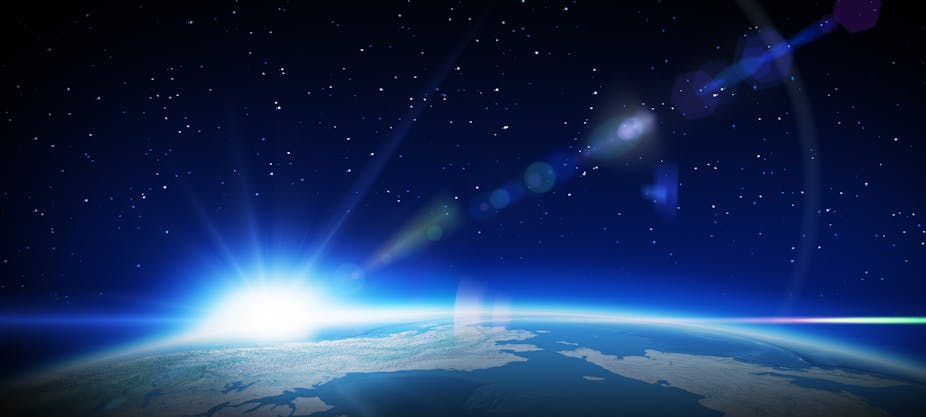
Curious Kids is a series for children of all ages. If you have a question you’d like an expert to answer, send it to [email protected] .
Have we made an object that could travel at at least 1% the speed of light? – Anadi, age 14, Jammu and Kashmir, India
Light is fast . In fact, it is the fastest thing that exists, and a law of the universe is that nothing can move faster than light. Light travels at 186,000 miles per second (300,000 kilometers per second) and can go from the Earth to the Moon in just over a second. Light can streak from Los Angeles to New York in less than the blink of an eye.
While 1% of anything doesn’t sound like much, with light, that’s still really fast – close to 7 million miles per hour! At 1% the speed of light, it would take a little over a second to get from Los Angeles to New York. This is more than 10,000 times faster than a commercial jet.
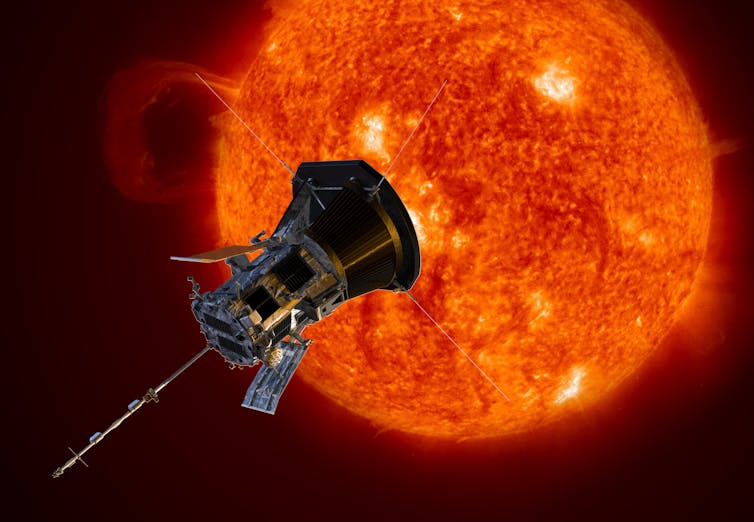
The fastest things ever made
Bullets can go 2,600 mph (4,200 kmh), more than three times the speed of sound. The fastest aircraft is NASA’s X3 jet plane , with a top speed of 7,000 mph (11,200 kph). That sounds impressive, but it’s still only 0.001% the speed of light.
The fastest human-made objects are spacecraft. They use rockets to break free of the Earth’s gravity, which takes a speed of 25,000 mph (40,000 kmh). The spacecraft that is traveling the fastest is NASA’s Parker Solar Probe . After it launched from Earth in 2018, it skimmed the Sun’s scorching atmosphere and used the Sun’s gravity to reach 330,000 mph (535,000 kmh). That’s blindingly fast – yet only 0.05% of the speed of light.
Why even 1% of light speed is hard
What’s holding humanity back from reaching 1% of the speed of light? In a word, energy. Any object that’s moving has energy due to its motion. Physicists call this kinetic energy. To go faster, you need to increase kinetic energy. The problem is that it takes a lot of kinetic energy to increase speed. To make something go twice as fast takes four times the energy. Making something go three times as fast requires nine times the energy, and so on.
For example, to get a teenager who weighs 110 pounds (50 kilograms) to 1% of the speed of light would cost 200 trillion Joules (a measurement of energy). That’s roughly the same amount of energy that 2 million people in the U.S. use in a day.
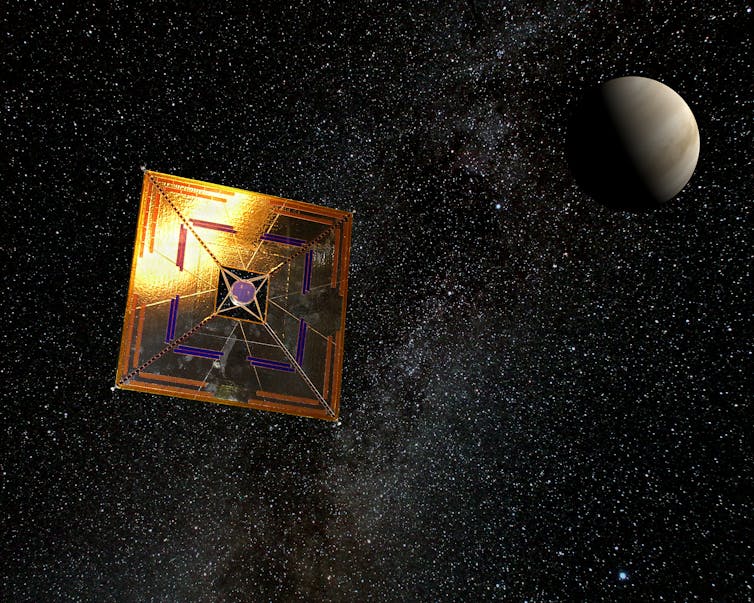
How fast can we go?
It’s possible to get something to 1% the speed of light, but it would just take an enormous amount of energy. Could humans make something go even faster?
Yes! But engineers need to figure out new ways to make things move in space. All rockets, even the sleek new rockets used by SpaceX and Blue Origins, burn rocket fuel that isn’t very different from gasoline in a car. The problem is that burning fuel is very inefficient.
Other methods for pushing a spacecraft involve using electric or magnetic forces . Nuclear fusion , the process that powers the Sun, is also much more efficient than chemical fuel.
Scientists are researching many other ways to go fast – even warp drives , the faster-than-light travel popularized by Star Trek.
One promising way to get something moving very fast is to use a solar sail. These are large, thin sheets of plastic attached to a spacecraft and designed so that sunlight can push on them, like wind in a normal sail. A few spacecraft have used solar sails to show that they work, and scientists think that a solar sail could propel spacecraft to 10% of the speed of light .
One day, when humanity is not limited to a tiny fraction of the speed of light, we might travel to the stars .
Hello, curious kids! Do you have a question you’d like an expert to answer? Ask an adult to send your question to [email protected] . Please tell us your name, age and the city where you live.
And since curiosity has no age limit – adults, let us know what you’re wondering, too. We won’t be able to answer every question, but we will do our best.
- Solar system
- Speed of light
- Curious Kids
- Curious Kids US
- Parker Solar Probe

Service Centre Senior Consultant

Director of STEM

Community member - Training Delivery and Development Committee (Volunteer part-time)

Chief Executive Officer

Head of Evidence to Action
3 Ways Fundamental Particles Travel at (Nearly) the Speed of Light
Light-speed travel is a staple of science fiction in space. No "Star Wars" movie seems complete until the Millennium Falcon (or a rival ship) uses its hyperdrive. And many "Star Trek" fans enjoy talking about the relative star-system-jumping speeds of the USS Enterprise, against the speeds of other Federation ships.
But in real life, physics gets in the way. Einstein's theory of special relativity essentially puts a speed limit on cosmic travel; as far as we can tell, nothing goes faster than the speed of light. Worse, any object that has mass tends to get more and more massive — dragging down the object's velocity — as it approaches light speed. So as far as we know, only small particles can get anywhere near the speed of light.
One hundred years ago, on May 29, 1919, scientists performed measurements of a solar eclipse that confirmed Einstein's work. To celebrate, NASA offered three ways that particles can accelerate to amazing speed in a new statement .
Related: Why Don't We Have a 'Star Wars' Hyperdrive Yet?
Electromagnetic fields
The sun is a wacky environment to study physics, because it is so extreme compared to Earth. It's also a real-life laboratory showing how nuclear reactions happen. It also is an example of an environment with electromagnetic fields — which, as NASA points out, is the same force that stops magnets from falling off your fridge.
Magnetic fields and electric fields work together to accelerate particles with an electric charge. This charge allows electromagnetic fields to push particles along — sometimes at speeds approaching the speed of light.
We can even simulate this process on Earth. Huge particle accelerators (like at the Department of Energy's Fermi National Accelerator Laboratory, or at the European Organization for Nuclear Research's Large Hadron Collider ) create pulsed electromagnetic fields. These fields accelerate charged particles close to the speed of light. Next, scientists often crash these particles together to see what particles and energy are released.
Get the Space.com Newsletter
Breaking space news, the latest updates on rocket launches, skywatching events and more!
In fractions of a second after these collisions, we can quickly observe elementary particles that were around in the first few seconds after the universe was formed. (That event, called the Big Bang , happened about 13.8 billion years ago.)
Magnetic explosions
The sun is also host to phenomena called solar flares . Dancing above the sun's surface is a tangle of magnetic fields. At times, these fields intersect and snap, sending plumes of solar material off the surface — and, sometimes, charged particles along with it.
"When the tension between the crossed lines becomes too great, the lines explosively snap and realign in a process known as magnetic reconnection," NASA officials said in the statement. "The rapid change in a region's magnetic field creates electric fields, which causes all the attendant charged particles to be flung away at high speeds."
Particles streaming off the sun may accelerate close to the speed of light, thrown from the sun thanks to magnetic reconnection. One example of such objects is the solar wind , the constant stream of charged particles the sun emits into the solar system. (There may be other factors speeding these particles as well, such as wave-particle interactions — which is explained in the next section of this article.)
Magnetic reconnection also likely happens at large planets, such as Jupiter and Saturn. Closer to home, NASA studies magnetic reconnection near Earth using the Magnetospheric Multiscale mission , which measures our planet's magnetic field using four spacecraft. The results may be useful to better understand how particles accelerate all over the universe, NASA officials said.
Wave-particle interactions
Particles can also careen at high speeds when electromagnetic waves collide; that phenomenon is more technically called wave-particle interactions.
"When electromagnetic waves collide, their fields can become compressed. Charged particles bouncing back and forth between the waves can gain energy similar to a ball bouncing between two merging walls," NASA officials said.
These interactions take place all over the universe. Near Earth, NASA missions such as the Van Allen probes are watching wave-particle interactions to better predict particle movements — and protect electronics on satellites. That's because high-speed particles can damage these delicate spacecraft parts.
Supernovas, or star explosions, may also play a role in more far-away interactions. Researchers have theorized that after a star explodes, it creates a blast wave — a shell of hot, dense compressed gas — that zooms away from the stellar core at high speed. These bubbles are full of charged particles and magnetic fields, creating a likely environment for wave-particle interactions. This process may eject high-energy cosmic rays — which consist of particles — at velocities close to the speed of light.
- Space Magnetism May Hold Secret to Fusion Power
- 'Superstar' Eta Carinae Acts Like a Ginormous Cosmic-Ray Gun, But Why?
- Halo Drive: Lasers and Black Holes Could Launch Spaceships to Near Light Speed
Follow Elizabeth Howell on Twitter @howellspace . Follow us on Twitter @Spacedotcom and on Facebook .
Join our Space Forums to keep talking space on the latest missions, night sky and more! And if you have a news tip, correction or comment, let us know at: [email protected].
Elizabeth Howell (she/her), Ph.D., is a staff writer in the spaceflight channel since 2022 covering diversity, education and gaming as well. She was contributing writer for Space.com for 10 years before joining full-time. Elizabeth's reporting includes multiple exclusives with the White House and Office of the Vice-President of the United States, an exclusive conversation with aspiring space tourist (and NSYNC bassist) Lance Bass, speaking several times with the International Space Station, witnessing five human spaceflight launches on two continents, flying parabolic, working inside a spacesuit, and participating in a simulated Mars mission. Her latest book, " Why Am I Taller ?", is co-written with astronaut Dave Williams. Elizabeth holds a Ph.D. and M.Sc. in Space Studies from the University of North Dakota, a Bachelor of Journalism from Canada's Carleton University and a Bachelor of History from Canada's Athabasca University. Elizabeth is also a post-secondary instructor in communications and science at several institutions since 2015; her experience includes developing and teaching an astronomy course at Canada's Algonquin College (with Indigenous content as well) to more than 1,000 students since 2020. Elizabeth first got interested in space after watching the movie Apollo 13 in 1996, and still wants to be an astronaut someday. Mastodon: https://qoto.org/@howellspace
UAE on track to launch bold 7-asteroid mission in 2028
Space pictures! See our space image of the day
'Lego Star Wars: Rebuild the Galaxy' premiers this week. Watch epic 1st clip (video)
Most Popular
- 2 Doom games ranked, worst to best
- 3 SpaceX will start launching Starships to Mars in 2026, Elon Musk says
- 4 This Week In Space podcast: Episode 127 — Space Stations Inc.
- 5 Boeing's Starliner capsule just landed with no crew aboard. What's next for this astronaut taxi?
- Subscribe to BBC Science Focus Magazine
- Previous Issues
- Future tech
- Everyday science
- Planet Earth
- Newsletters
© Getty Images
What would you see if you could travel at the speed of light?
Einstein's Special Theory of Relativity was born from this very question, and the answer is as weird as you'd expect.
Robert Matthews
Asked by: Pete Groves, London
That's what Einstein asked himself as a schoolboy and it led him to his famous Special Theory of Relativity. Its equations show that objects look increasingly distorted as the speed of travel increases, with the view ahead becoming progressively brighter. Then truly bizarre effects start to kick in, with objects far ahead apparently moving further away, while those behind come into view.
Eventually, at lightspeed there's nothing but a dazzingly bright spot of light surrounded by complete blackness. Weird!
- Does the speed of light ever change?
- What is the speed of thought?
Subscribe to BBC Focus magazine for fascinating new Q&As every month and follow @sciencefocusQA on Twitter for your daily dose of fun science facts.
Share this article

- Terms & Conditions
- Privacy policy
- Cookies policy
- Code of conduct
- Magazine subscriptions
- Manage preferences
This Trick Flips Space and Time

By Meddling With Spacetime Dimensions, We Could Finally Reach Warp Speed
New research shows that the “superluminal observer” needs three separate time dimensions for a warp-speed math trick that would please even Galileo.
✅ Quick Facts:
- A faster-than-light “observer” would take general relativity to new quantum places.
- In new research, the lead scientist explains why just one space and one time aren’t enough for this scenario.
- Symmetry is a physics concept that goes all the way back to Galileo’s time.
The secret to faster-than-light physics could be to double down on the number of dimensions. Specifically, the solution may lie in three dimensions of time , with just one representing space. The math is deep and complicated, but the ideas may be within our grasp after all. And there’s one math trick at superspeeds that may just “flip” your lid.
The key idea at play is that of a “superluminal observer,” according to research published in December 2022 in the journal Classical and Quantum Gravity. “Superluminal” means faster than light, from super - meaning “more” or “most,” and - luminal like, well, Lumière from Beauty and the Beast, and the lumens that power your home movie projector. The superluminal observer is a hypothetical thing that is looking at the universe while traveling faster than light. It’s you in your Star Trek warp-speed shuttle.
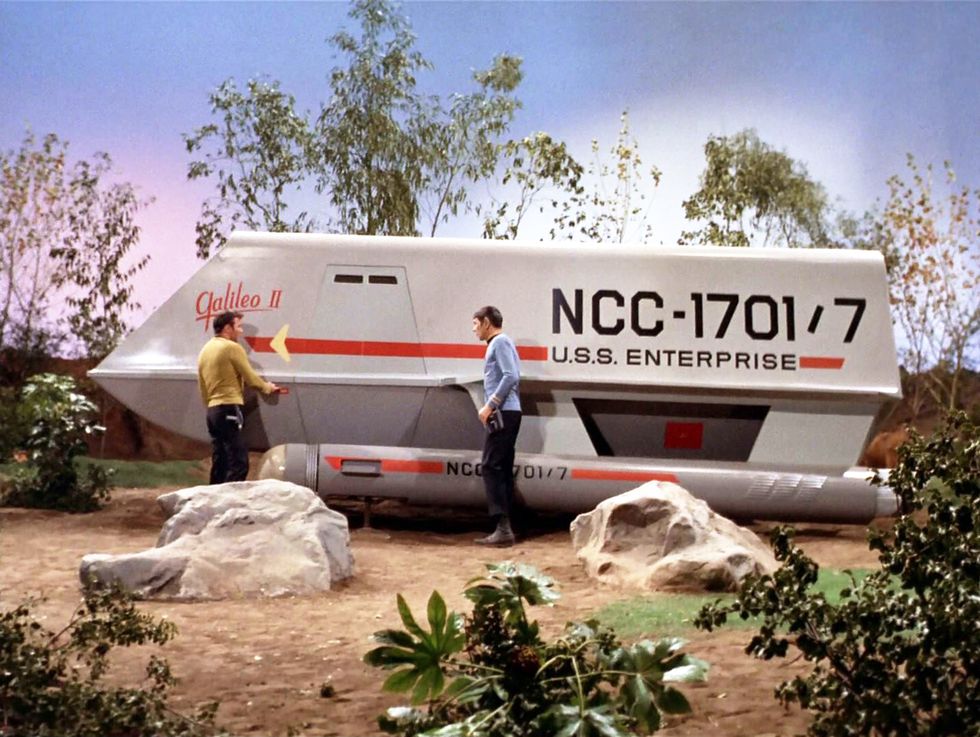
Superluminal observers are cool because, in a way, they marry together two very different sides of physics: general relativity and quantum mechanics . General relativity is the work embodied by Albert Einstein, which governs how spacetime functions as bodies move around the universe at subluminal, or slower than light, speeds. Quantum mechanics explains how subatomic particles behave, or don’t behave, in very strange ways on the smallest of scales.
The research team—led by theoretical physicist Andrzej Dragan of the University of Warsaw and the National University of Singapore—has theorized that many parts of quantum physics, like indeterminism and superposition , can be explained if you take general relativity and apply its principles to the superluminal observer. In other words, how messy does spacetime get if we take our shuttle up to warp speed? Is everything suddenly in multiple places at once?
Dragan’s new work indicates that it’s at least a possibility. Perhaps more interestingly, the way general relativity becomes quantum phenomena at speeds greater than light doesn’t seem to introduce any causal paradoxes. In earlier work , published in the New Journal of Physics in March 2020, Dragan and his coauthor studied “just” one space dimension and one time dimension, known as 1+1. In the new paper, the researchers upped the ante to include one space dimension and three time dimensions, or 1+3.
When Time and Space Flip Math
Why do we need three time dimensions? To understand, we have to talk about some math. “[D]espite our common perception, time and space are strikingly similar according to relativity, and mathematically the only difference between them is the minus sign somewhere in the equations,” Dragan explains to Popular Mechanics in an email. That’s a small difference in complicated math, but think of the algebra example of the difference of two squares: x² - 16, for example, is the result of (x - 4)(x + 4). With one flipped sign, the middle term in the polynomial falls away.
But when the observer is going faster than the speed of light, the difference in signs also changes. That’s because time and space must flip in the math. “The time of the superluminal observer becomes space of the subluminal one, and their space becomes time,” Dragan says. In other words, the regular, non-light-speed observer’s space and time turn into the time and space, relatively, of the faster-than-light observer. “So their corresponding signs have to interchange.”
In a 1+1 scenario, that means the two dimensions are the same, making it redundant. If 50 = 50, does it matter which 50 is which? (In logic, we call this a tautology.) That means that if we want to truly study space and time as different things, we have to add a second “set” of two dimensions: space and time 1, together, represent space; while time 2 and time 3, together, represent time . It’s not quite the difference of two squares, but we have two balanced sets of dimensions.
The Symmetry in Physics

There’s another interesting aspect to this research, because Dragan’s team wants to show that even at superluminal speeds, physics shows symmetry.
“The idea of symmetry in physics can be traced back to Galileo,” Dragan says. “He noticed that no matter what velocity we move at, as long as that velocity is constant, our physics remains the same. A parrot flying in a moving ship experiences the same dynamical laws as at ‘rest’ on Earth.”
✅ Galileo Galilei was an influential Italian scientist who lived during the 16th and 17th centuries. As an elderly man, he received a life sentence for going public with his belief that Earth orbited the sun!
But our conceptions of physics are limited by the long-running (and reasonable!) belief that nothing can travel faster than light, Dragan explains. That means the superluminal observer, by definition, exists as a kind of exception into which we must work to extend the idea of symmetry. Does it make sense that a superluminal observer would still be subject to symmetry? Is the parrot traveling faster than light still the same as the parrot in the ship or on Earth?
“We argued that this additional limiting assumption isn’t necessary,” Dragan says. He believes symmetry may extend into faster-than-light speeds, and our parrot friend would be just as affected by the same laws of physics while traveling in the warp-speed shuttle.
Toward a Grand Unified Theory
So, this paper isn’t about traveling at warp speed, but instead an analysis of physics to show how we can bring two very different physics branches together. Why is that, itself, so important?
“The idea of more than one time dimension has been considered by others over the years, so that particular premise is not novel,” Harold “Sonny” White, a onetime NASA physicist and the founder of the Limitless Space Institute (LSI), a group that funds and promotes far-out space travel and physics research, tells Popular Mechanics . “But the mathematical framework developed by the authors in this published paper is unique. It would seem the authors’ perceived benefit from the effort is that it establishes a mathematical basis for why we need a field theoretical framework.”

What is a field theoretical framework? It’s the big picture of physics that can bring everything together. “[I]f we envision the standard models of physics as a Venn diagram, there would be two circles side-by-side that touch at a single tangent point,” White explains. “The idea of a grand unified field theory might be envisioned as a larger circle that encircles both the smaller circles.”
By showing their work, these researchers have pointed out a really specific way in which one big basket of physics—rather than two baskets that we aren’t sure how to carry at the same time—would make more sense in practical and mathematical terms.
Okay, sure, you may be thinking: all this superluminal jabberwocky is interesting. But warp speed itself is science fiction, right? (At least for now: White’s LSI funds education that may eventually lead us elsewhere.) The superluminal observer is just a thought exercise ... right?
Dragan isn’t so sure. “The last remaining question is whether superluminal objects are only a mathematical possibility, or they actually exist in reality,” he concludes. “We believe the latter to be that case, and that is the purpose of our further research.”
That means our warp-speed shuttle, once the most far-out thing science fiction writers could even imagine, could embody an elegant theory that brings together two very different kinds of physics. Indeed, objects in the superluminal mirror may be closer than they appear.

Caroline Delbert is a writer, avid reader, and contributing editor at Pop Mech. She's also an enthusiast of just about everything. Her favorite topics include nuclear energy, cosmology, math of everyday things, and the philosophy of it all.

Pop Mech Pro: Space

This Laser Could Unlock Interstellar Travel

Warp Drives Are Possible—Aliens May Be Using Them

The Universe Could Be Eternal, This Theory Says

How a Lunar Supercollider Could Upend Physics
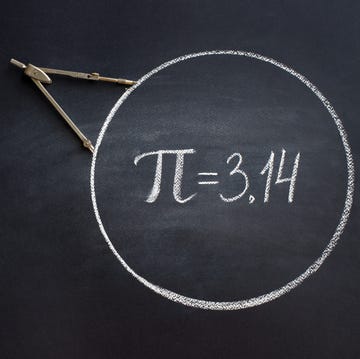
The History of Pi

The Strange Origin of the Hollow Moon Conspiracy

What Do Alien Space Probes Look Like?
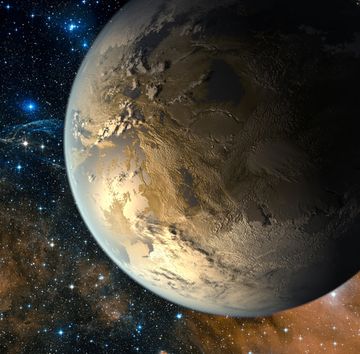
How NASA’s Next Super Telescope Could Find Aliens

Will Mars Astronauts Need Sunscreen?
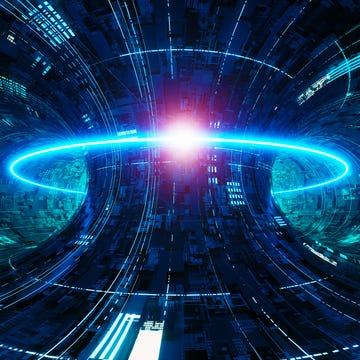
Sunquakes May Be the Key to Nuclear Fusion

7 Solid Reasons to Actually Believe in Aliens

The 7 Greatest Cosmic Threats to Life on Earth

Photon Travel: How Fast Does a Photon Travel and the Mysteries of Light Speed
Photons are particles of light. They travel through a vacuum at about 670,616,629 miles per hour (or 299,792 kilometers per second). This speed is constant and represents the ultimate speed limit in the universe, as stated by the theory of special relativity.
Despite its consistent speed, the behavior of photons raises intriguing questions. For instance, photons can exhibit dual characteristics, acting both as particles and waves. This duality leads to phenomena such as interference and diffraction, which are essential to understanding light behavior. Moreover, when photons travel through different mediums, such as glass or water, they slow down, creating an apparent change in speed.
Scientists continue exploring the mysteries of light speed. Researchers study how photons interact with matter and each other. They also investigate how light influences time and space. These inquiries further our understanding of the universe.
Understanding photon travel and speed is crucial for advancements in technology, such as telecommunications and medical imaging. The implications of light speed extend well beyond theoretical physics, opening doors to innovations still unfolding.
Table of Contents
How Fast Does a Photon Travel in a Vacuum?
A photon travels in a vacuum at a speed of approximately 299,792 kilometers per second, or about 186,282 miles per second. This speed is universally recognized as the speed of light, denoted by the symbol “c”. In a vacuum, photons move unimpeded, as there are no particles or obstacles to slow them down. This speed is a fundamental constant of nature, meaning it does not change under normal conditions and is pivotal in theories of physics, including relativity.
What Factors Can Influence Photon Speed in Different Mediums?
Several factors can influence photon speed in different mediums.
- Medium composition
- Temperature
- Quantum effects
Understanding these factors provides insights into the behavior of light and its interaction with various materials.
Medium Composition : The composition of a medium significantly affects photon speed. When light travels through materials like air, water, or glass, its speed decreases due to interactions with the atoms of the medium. Each material has a specific refractive index, which determines how much light is slowed down. For instance, the speed of light in a vacuum is approximately 299,792 kilometers per second, but it slows to about 225,000 kilometers per second in glass.
Temperature : Temperature can also alter how light travels through a medium. As temperature increases, the kinetic energy of the molecules in a medium rises, potentially causing changes in density or the arrangement of molecules. This affects the refractive index. For example, warmer air can lead to slightly different light speeds due to changes in density and refractive properties. Research by P. W. Milonni (1999) highlights that temperature changes can modify light travel times in various scenarios.
Density : The density of a medium correlates with how closely packed its particles are. Generally, light travels slower in denser mediums. In denser materials like diamond, light significantly slows down due to the tightly packed atoms interacting with the photons. This relationship follows the equation of refractive index, where higher density results in a higher refractive index and thus a lower speed of light.
Wavelength : The wavelength of light can affect its speed in certain materials due to dispersion. Different wavelengths experience different refractive indices; for example, blue light travels slower than red light in glass. This results in phenomena like rainbows, where light separates into its component colors. Studies have shown that this dispersion can drastically affect practical applications, such as fiber optics.
Frequency : Frequency is inversely related to wavelength; therefore, changes in frequency can influence how light interacts with materials. Higher frequency waves may interact differently with atomic structures than lower frequency waves. In some contexts, certain frequencies can resonate with atoms, leading to increased absorption and reduced speed of photons. This principle is applied in laser technology and telecommunications.
Quantum Effects : Quantum mechanical properties of materials can also impact photon velocity. In some contexts, phenomena like quantum entanglement and superposition play a role in how light behaves on a microscopic level. For instance, researchers have found instances where light pulses can be slowed to a fraction of its speed through specific arrangements of quantum materials. Studies by K. M. Beck et al. (2017) reveal that these effects can be harnessed for advanced technologies, like slower-than-light information transfer.
In summary, multiple factors affect how fast a photon travels in various mediums. These include the composition, temperature, density, wavelength, frequency, and quantum effects. Understanding these factors is crucial for applications in optics, telecommunications, and material science.
How Does the Medium Affect the Speed of a Photon?
The medium affects the speed of a photon by altering its velocity as it travels through different materials. In a vacuum, a photon moves at its maximum speed, which is approximately 299,792 kilometers per second (km/s). However, when a photon enters a medium such as glass or water, it interacts with the atoms in that material. This interaction leads to a decrease in its effective speed.
The main concepts involved are the medium, the photon, and light speed. When light passes through a medium, it slows down due to refraction. Refraction occurs because light takes time to move through the atoms of the medium. Essentially, photons get absorbed and re-emitted by the atoms, which delays their travel time.
The logical steps to understand this are as follows:
- Identify the speed of light in a vacuum.
- Understand how light interacts with different media.
- Recognize that the effective speed of light decreases in denser media.
These steps connect by demonstrating that the interaction of light with the medium’s structure is what ultimately affects its speed. The denser the medium, the slower light travels through it. By synthesizing this information, it becomes clear that the speed of a photon is not constant; it varies depending on the medium’s properties.
What Impact Does Temperature Have on Photon Speed?
The temperature does not impact the speed of photons in a vacuum. Photons, which are particles of light, always travel at the constant speed of approximately 299,792 kilometers per second (186,282 miles per second) in vacuum, regardless of temperature conditions.
- Speed of photons remains constant in vacuum.
- Interaction with materials can vary with temperature.
- Temperature affects the behavior of light in different mediums.
- Increased temperature influences the refractive index.
- Perspectives on the relationship between light speed and various phenomena.
The fixed speed of photons in a vacuum creates a foundation for understanding their behavior in other contexts.
Speed of Photons Remains Constant in Vacuum: The speed of photons, or light, stays constant at approximately 299,792 kilometers per second in a vacuum. This value is fundamental in physics and is denoted as “c.” According to the theory of relativity formulated by Albert Einstein, nothing can travel faster than light in a vacuum. This principle is essential for concepts such as time dilation and the structure of spacetime.
Interaction with Materials Can Vary with Temperature: When photons travel through different materials, their speed can change based on the material’s properties. However, temperature influences these properties. For example, light travels slower in dense materials like glass than in a vacuum. If the temperature of the glass changes (e.g., by heating), it may alter the density and thus the speed of light within it.
Temperature Affects the Behavior of Light in Different Mediums: The temperature of a medium impacts how light behaves as it passes through. As temperatures rise, the arrangement of particles can change, affecting the scattering and absorption of light. This is often observed in gases, where higher temperatures lead to increased molecular motion, influencing how photons interact with these molecules.
Increased Temperature Influences the Refractive Index: The refractive index of a material gauges how much light bends as it enters the substance. Temperature changes can affect the refractive index. For instance, in air, an increase in temperature typically causes a decrease in the density of the air, which in turn can lower the refractive index, altering the light’s path.
Perspectives on the Relationship Between Light Speed and Various Phenomena: Some scientists and researchers explore the relationship between light speed and temperature through various frameworks. For instance, quantum physics suggests that the interactions between photons and matter can lead to phenomena like changes in light’s speed in specific contexts, even if the speed of light in a vacuum remains constant. Others argue that discussions around varying light speeds can confuse fundamental principles, which remain consistent despite external conditions.
What Is the Relationship Between Photon Speed and the Speed of Light?
The speed of light in a vacuum is approximately 299,792 kilometers per second. Photons are particles of light, and they travel at this speed. This speed is often denoted as “c” in scientific equations and is considered a fundamental constant of nature.
The National Aeronautics and Space Administration (NASA) defines the speed of light as the ultimate speed limit in the universe, stating that it is the speed at which all massless particles and associated fields propagate through a vacuum.
Photons, being massless particles, travel at the speed of light. Their speed remains constant regardless of the observer’s motion or the source’s motion. This means that in a vacuum, light from any source will always travel at the same speed.
According to the European Space Agency (ESA), the speed of light remains unchanged across different forms of light. This includes visible light, radio waves, and gamma rays. Other sources emphasize that photons enter different media at varying speeds, which affects their overall speed but does not change the inherent speed of photons themselves when in a vacuum.
Factors influencing photon speed include the medium through which they travel and electromagnetic fields. When photons pass through denser materials, like glass or water, they slow down due to interactions with atoms in the medium.
Research indicates that light traveling through water moves at approximately 75% of its speed in a vacuum. Further, this property has implications for technologies such as fiber optics and communications systems, where light speed affects data transmission rates.
The speed of light influences numerous sectors. In telecommunications, faster data transfer enables quicker communications. In healthcare, light’s interactions with tissue can improve imaging techniques, enhancing diagnostics.
Examples include optical fibers used in high-speed internet that rely on light traveling with minimal delay. In medicine, lasers are used in surgery, where precision and speed are critical.
To optimize the benefits of photon applications, experts suggest investing in research on new materials to enhance light propagation. NASA refers to this as improving optical systems for advanced spacecraft communications and navigation.
Strategies encompass developing advanced optical materials, enhancing laser technologies, and exploring quantum communication. Efforts from entities like the IEEE focus on improving optical fiber systems and increasing light transmission efficiency.
What Are the Implications of Photon Speed for Modern Physics?
The implications of photon speed for modern physics are significant. The speed of a photon, which travels at approximately 299,792 kilometers per second in a vacuum, serves as a universal constant. This speed impacts theories related to relativity, causality, and the structure of space and time.
- Foundation of Special Relativity
- Limit on Information Transfer
- Causality and Temporal Order
- Technological Applications
- Quantum Mechanics and Entanglement
- Alternative Theories and Perspectives
Photon speed serves as the foundation of special relativity. This theory, formulated by Albert Einstein in 1905, posits that the laws of physics remain consistent for all observers, regardless of their relative motion. It also states that nothing can travel faster than the speed of light in a vacuum. According to the Einstein’s equation E=mc², this constant influences mass-energy equivalence and the relationship between energy and mass.
Photon speed sets a limit on information transfer. Information and matter cannot exceed light speed, which has profound implications for communication and travel in the universe. It means that there is a fundamental cap on how quickly events can influence each other across space.
Photon speed dictates causality and temporal order. Events that occur faster than light can create paradoxes, challenging our understanding of cause and effect. For instance, signaling before the effect occurs would undermine the principle that cause precedes effect.
Photon speed finds applications in technology. For example, fiber-optic communication relies on the speed of light for transmitting data. Advances in telecommunications benefit from understanding light’s behavior.
Photon speed relates to quantum mechanics and entanglement. Entangled particles seem to affect one another instantaneously, no matter the distance. This phenomenon raises questions about locality and the transmitted signals, as it appears to defy the speed of light limit.
Alternative theories and perspectives challenge the concept that photon speed is an absolute limit. Some researchers propose modifications to our understanding of space-time or explore theories beyond standard physics, like quantum gravity.
In conclusion, the speed of photons shapes fundamental concepts in modern physics and continues to incite exploration and discussion within the scientific community.
How Do Scientists Accurately Measure the Speed of Photons?
Scientists measure the speed of photons with great precision using methods like time-of-flight experiments and resonance techniques. These methods are based on the principles of light behavior and require careful calibration.
Time-of-flight experiments: This method involves measuring the time it takes for a photon to travel a known distance. Researchers emit a pulse of light and use highly accurate clocks to record when the photon leaves and arrives. A landmark study by Heisenberg (1952) established this method with impressive accuracy, achieving results consistent with the speed of light in a vacuum, approximately 299,792 kilometers per second.
Resonance techniques: Scientists also utilize resonance absorption to measure photon speed. This technique involves sending light through a gas and observing how the light’s frequency changes when it interacts with atomic particles. The shift provides data on speed. An example is the work by Miller (1972), who utilized helium gas to measure light speed with an accuracy of a few parts per billion.
Particle colliders: Facilities like the Large Hadron Collider (LHC) provide another method. They accelerate particles close to light speed and measure interactions that occur during collisions. Researchers infer photon speeds from these interactions. A notable finding by Evans et al. (2008) showed photons maintain consistent speed regardless of the energy levels involved.
Experimental setups: Precision laser setups often include a beam splitter to direct light beams along different paths. The arrival times are compared to confirm speed. Advanced detectors capture minute differences. A study by Kwiatkowski et al. (2019) highlighted advancements in this field, leading to refined measurements of photon speed.
By leveraging these methods, scientists consistently confirm that photons travel at an invariant speed in a vacuum, reinforcing fundamental theories in physics such as Einstein’s special relativity. Accurate measurements of light speed are crucial for fields ranging from telecommunications to cosmology.
What Common Misconceptions Exist About Photon Travel?
Photon travel often leads to misconceptions regarding its speed and behavior. A common misunderstanding is that photons can travel faster than the speed of light in a vacuum, which is not true.
- Photons have mass.
- Photons can exceed the speed of light.
- Photons always travel in straight lines.
- Photon speed changes based on the medium.
- Photons can carry information faster than light.
The above points illustrate prevalent misconceptions regarding photon travel. Understanding these misconceptions can help clarify many common misunderstandings about light and its behavior.
Photons Have Mass : The misconception that photons have mass stems from their interaction with gravity. In reality, photons are massless particles. According to Einstein’s theory of relativity, massless particles can only travel at the speed of light, which is approximately 299,792 kilometers per second (186,282 miles per second) in a vacuum. Their lack of mass allows them to travel unimpeded at light speed.
Photons Can Exceed the Speed of Light : Many people mistakenly believe that photons can exceed light speed. However, according to the principles established by Einstein, nothing with mass can reach or exceed the speed of light. Photons, being massless, always travel at light speed in a vacuum. Research conducted by scientists at CERN has shown that no observed particles have surpassed the speed of light.
Photons Always Travel in Straight Lines : It is a common belief that photons inherently travel in straight lines. However, photons can be affected by gravitational fields, causing them to bend. This phenomenon is evident in gravitational lensing, where light curves around massive objects, a concept supported by general relativity and demonstrated during solar eclipses as shown by observations from the early 20th century.
Photon Speed Changes Based on the Medium : While it is true that the speed of light varies depending on the medium, the speed of a photon in any medium is less than its speed in a vacuum. For example, light travels slower in water or glass than in air. When light enters a denser medium, it is absorbed and re-emitted by atoms within that medium, leading to a perceived reduction in speed. This process is supported by studies in optics and is crucial to understanding phenomena such as refraction.
Photons Can Carry Information Faster Than Light : Some argue that photon-based communication methods can transmit information faster than light. This notion is misleading because while quantum entanglement may suggest instantaneous connections, it does not allow for practical, faster-than-light communication. According to principles derived from quantum mechanics, actual information transfer requires classical channels still bounded by the speed of light, as explained by scientists like Albert Einstein and David Bohm.
These clarifications help demystify common misconceptions about photon travel, solidifying our understanding of light behavior and its fundamental principles.
What Future Research Is Exploring the Mysteries of Photon Speed?
Research into the mysteries of photon speed focuses on several key areas.
- Theoretical physics and relativity
- Quantum mechanics and entanglement
- Experimentation with superluminal speeds
- The relationship between photons and gravitational fields
- Technological applications in communication and computing
These research areas present a diverse perspective on understanding photon behavior and speed. Each perspective contributes to a more comprehensive understanding of light’s nature.
Theoretical Physics and Relativity : Research in theoretical physics examines the concept of relativity as it applies to photon speed. Photons travel at the speed of light in a vacuum, which is approximately 299,792 kilometers per second. According to Einstein’s theory of relativity, nothing with mass can reach or exceed this speed. The framework provided by relativity offers explanations for why photon behavior appears to defy certain classical physics principles.
Quantum Mechanics and Entanglement : Quantum mechanics explores the behavior of photons at subatomic levels. Quantum entanglement describes a phenomenon where two or more particles become interconnected, and the state of one instantly influences the state of another, regardless of distance. This suggests that information can be exchanged faster than light, raising questions about conventional understandings of photon speed.
Experimentation with Superluminal Speeds : Some recent studies seek to explore the possibility of superluminal (faster-than-light) speeds in specific conditions. For example, experiments involving light pulses in specific materials have shown that information may traverse faster than light under certain conditions. While these findings do not imply that photons themselves exceed light speed, they challenge traditional perspectives.
The Relationship Between Photons and Gravitational Fields : Researchers investigate how gravitational fields affect the path and speed of photons. According to general relativity, massive objects can bend spacetime, altering how photons travel. This interplay suggests complexities in our understanding of light speed as it interacts with gravitational forces, reflecting the idea that the context of travel can influence speed.
Technological Applications in Communication and Computing : Research into photon speed also explores its applications in technology. Photons form the basis of fiber-optic communication and quantum computing, where their speed impacts transmission rates and data processing. Advances in these fields hinge on harnessing photon behavior, making it a crucial area of exploration for future technological development.
Overall, ongoing research examines the speed of photons from various angles, providing insights that challenge existing paradigms and open new avenues for discovery.
- How fast does a paintball travel
- How fast does a nuclear blast travel
- How fast does a neuron travel
- How fast does a missile travel
- How fast does a meteor travel

IMAGES
VIDEO
COMMENTS
Three Ways to Travel at (Nearly) the Speed of Light
Can We Travel At The Speed Of Light? No, humans cannot survive traveling at the speed of light. When an object moves at the speed of light, its mass increases exponentially. For instance, the speed of light is 299,792 kilometers per second (186,282 miles per second), and when an object travels at this speed, it behaves as if it has infinite mass.
Will Light-Speed Space Travel Ever Be Possible?
How fast could humans travel safely through space?
"There are some important things you should probably know about approaching the speed of light," NASA's video, Guide to Near-light-speed Travel, explains. "First, a lot of weird things can happen ...
The theory of special relativity showed that particles of light, photons, travel through a vacuum at a constant pace of 670,616,629 miles per hour — a speed that's immensely difficult to achieve and impossible to surpass in that environment. Yet all across space, from black holes to our near-Earth environment, particles are, in fact, being ...
Speed of light: How fast light travels, explained simply and ...
Why does time change when traveling close to the speed ...
Speed of light
How fast does light travel? | The speed of light
Luckily for all of us, NASA addresses these in a recently-released animated video that covers all the basics of interstellar travel! To summarize, according to the immutable laws of physics (specifically, Einstein's Theory of Special Relativity), there's no way to reach or exceed the speed of light. This means that if you're going to attempt ...
Huygens came up with a figure of 131,000 miles per second (211,000 kilometers per second), a number that isn't accurate by today's standards — we now know that the speed of light in the "vacuum ...
Have we made an object that could travel 1% the speed of ...
The speed limit is a harsh reality. The reason that it is hard to travel through space at the speed of light is that you must push the object out of moving in the time direction to moving more in ...
Albert Einstein's special theory of relativity states that photons—or particles of light—travel at a constant speed of 670,616,629 miles per hour. As far as we know, nothing can travel faster ...
So as far as we know, only small particles can get anywhere near the speed of light. One hundred years ago, on May 29, 1919, scientists performed measurements of a solar eclipse that confirmed ...
1 To travel backward in time, the spacecraft's velocity must exceed: where u is the velocity of the planet relative to Earth, and c is the speed of light. Seth Lloyd, professor of quantum ...
Here's How. Scientists Believe Light Speed Travel Is Possible. Here's How. A functioning warp drive would allow humans to reach the far ends of the cosmos in the blink of an eye. I n late 2020 ...
The fact is we'll never be able to travel beyond the speed of light, at least based on our current understanding of established physics. As any object with mass accelerates - like a proton in ...
What would you see if you could travel at the speed of light?
Symmetry is a physics concept that goes all the way back to Galileo's time. The secret to faster-than-light physics could be to double down on the number of dimensions. Specifically, the ...
Lentz's solution would allow the bubble to travel faster than the speed of light. ... As a physicist, I won't fully trust models until we have experimental proof. Yet, the science of warp ...
For decades, we've dreamed of visiting other star systems. This is an area that attracts plenty of bright ideas, each offering a different approach to solving the puzzle of faster-than-light travel: achieving a means of sending something across space at superluminal speeds.. Hypothetical travel times to Proxima Centauri, the nearest-known star to the Sun. (E. Lentz)
In reality, photons are massless particles. According to Einstein's theory of relativity, massless particles can only travel at the speed of light, which is approximately 299,792 kilometers per second (186,282 miles per second) in a vacuum. Their lack of mass allows them to travel unimpeded at light speed.